Blog categories
Blog archive
RSS Blog posts tagged with 'Dining'
Blog Filters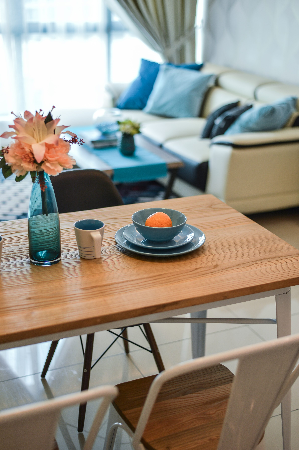
Centre of Attention: 7 Centrepiece Ideas for Your Dining Table
Friday, November 20, 2020
If you have just finished adjusting your dining table and meticulously arranging it in place in your home, only to have that nagging feeling that the décor is somehow incomplete, it is because the space needs a centrepiece.
You could do as one does and just let clutter accumulate just to see what happens, the random assortment of items will eventually speak of your personality and lifestyle, but it may not blend well with the rest of the space - that and most would regard that as an unintended mess. We let our panel of decorators into our homes to help us figure out centrepieces, and arrived at the following Top 7 ideas that will help you get ahead of the curve by tailoring your dining table decorations to suit your interior and to project the ambiance you design.
 Designer: Konan Design
Designer: Konan Design
7. Classic Candlelight The original dining table centrepiece - the archetypal candle and candle-holder combination has been a pervasive decorative element, providing a form of lighting especially suited for intimate moods, and appearing in everything from classical art to modern fine dining experiences. Candle-holders serve as pieces of art in themselves, ranging from ostentatious candelabra gilded in precious metals to utilitarian glassware.
 Designer: SQFT Space Design Management
Designer: SQFT Space Design Management
6. Edible Art Food invariably gets left on the dining table in some way or another - especially with large households in constant flux, where mealtimes tend to overlap. Embrace the familial chaos while encouraging healthy eating by displaying brightly coloured fruit or snacks in attractive containers to provide an additional decorative element. To take it a step further, unleash the inner epicurean and artist by experimenting with pickled or dried edibles in jars to produce a few splashes of colour.
 Designer: Surface R Interior Design
Designer: Surface R Interior Design
5. Rotating Trays A mainstay of oriental-styled interiors, the turntable - known in some circles as the "Lazy Susan", is a rotating tray made of wood or stone. Typically found in the centre of large Chinese dinners, the turntable adds a functional and elegant layer to round dining tables that serves equally well as a pedestal for art or dining accessories - while providing diners with Arthurian access to the dishes placed on it.
 Designer: Jashen Interior Design
Designer: Jashen Interior Design
4. Sculptures On the other end of the function-form spectrum are gratuitous objects of art to inject some glam and glitter into a scene and turn a dining table into a display space. A curated sculpture with interesting reliefs on all sides provides luxurious views from any angle in combination with a rotating tray.
 Designer: Gusto Design
Designer: Gusto Design
3. Literary Pursuits In lieu of spending the time combing galleries and markets for "that ideal piece", go the way of the literary artist by shaping an impromptu sculpture out of books to accent a loft-like décor. Especially in small spaces where coffee table space is scarce, books that were intended for the seating lounge can be piled up on the dining table instead, freeing up living room space and providing a set of spontaneous talking points while dining.
 Designer: M Innovative Builders
Designer: M Innovative Builders
2. Living Embellishments A simple and immediately rewarding centrepiece element comes from our own lush backyards. All that is needed is a few stalks of freshly-cut flowers, or sprigs of herbs, thrown into a container - anything from an old tea tin to an intricate glass vase would do the job. While these living centrepieces can only be expected to last little more than a few days, an extra "wow" could be elicited with a contained ecosystem of live fish and water plants in the centre of the dining table.
 Designer: Q1 Interior
Designer: Q1 Interior
1. Clutter Trays To keep that assortment of decorative and functional items in check, consider using a tray in wood or metal to neatly present dining table accessories, and to add another layer of texture to dining surfaces. Aside from the obvious practical application, clutter trays can also be used to frame other decorative elements, or even create a mini Zen garden with appropriately deep trays filled with sand.
 Designer: X-Two Concept
If you haven't already, click here to take a look at our definitive guide for selecting the right kind of dining table to suit your interior.
Designer: X-Two Concept
If you haven't already, click here to take a look at our definitive guide for selecting the right kind of dining table to suit your interior.
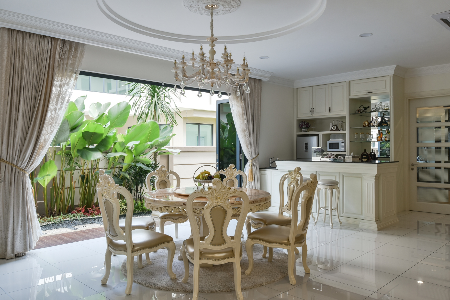
Dine in Style: A Dining Table Buying Guide for Every Homeowner
Friday, November 20, 2020
As the dining space is arguably the most likely part of a home where family members can be expected to congregate, the selection of a dining table is probably the most important decision to be made - at least with regards to furnishings. We understand that the wide range of styles and materials available for dining tables may be overwhelming for most, so we put together this definitive guide to assist you in your search for the perfect dining table.
Material
The materials commonly used in dining tables greatly affect their longevity in terms of substance as well as style. Hardwoods, metals, tempered glass, stone, and even mould-injected plastics tend to be the materials of choice for long-term furnishings expected to endure years of physical impacts and spills. On the end of the scale would be the lightweight or flat-pack designs composed of veneered wood composites such as plywood and fibreboard. These engineered composites are significantly less durable, showing a tendency to warp when subjected to excessive moisture or heat. On the plus side, tables made of these materials are preferred for short-term and low-frequency applications as they tend to be easier to repack and move by design.
Natural materials such as hardwoods and stone tend to be porous, requiring regular maintenance and a coat of varnish or sealer to prevent permanent staining from everyday use - however artisans attest to some aesthetic benefits derived from a deliberate patina providing a personalized tinge to these natural materials.
 Natural materials such as hardwoods and stone tend to be porous, requiring regular maintenance and a coat of varnish or sealer to prevent permanent staining from everyday use. From iN Design Bumper Issue 2016. Image Credit: Latitude Design
Natural materials such as hardwoods and stone tend to be porous, requiring regular maintenance and a coat of varnish or sealer to prevent permanent staining from everyday use. From iN Design Bumper Issue 2016. Image Credit: Latitude Design
Metals would also need to be protected, albeit to a lesser degree by virtue of their inherent durability. Metal furnishings are at the highest risk of deterioration by rust when used outdoors, and especially when lacking a protective coating. To ensure the longest possible lifespan, a metal dining table should be powder-coated in carbon to provide protection against scratches.
Dining tables sporting tempered glass tops are much sought after as they provide a balance between eye-pleasing aesthetics and durability in their reflective surfaces. While glass is naturally lower in impact resistance when compared to metal, modern tempered glass is manufactured at such high pressures that its durability is virtually guaranteed in everyday circumstances.
 Dining tables sporting tempered glass tops are much sought after as they provide a balance between eye-pleasing aesthetics and durability in their reflective surfaces. From iN Design Bumper Issue 2016. Image Credit: The Roof Studio
Dining tables sporting tempered glass tops are much sought after as they provide a balance between eye-pleasing aesthetics and durability in their reflective surfaces. From iN Design Bumper Issue 2016. Image Credit: The Roof Studio
Mould-injected plastics are likely the most economical and durable solution for outdoor applications but as white plastics tend to turn yellow with age, care should be taken to minimize their exposure to direct sunlight.
Size
One of the most crucial considerations for your dining table would be its dimensions, as a dining table that is too large for its space forces diners to squeeze through narrow gaps between the wall and their seats. We recommend allowing for gaps between 90 centimetres to 1.3 meters (or 36 to 50 inches) of space between a dining table and the surrounding walls to enable diners to comfortably take their seats.
 We recommend allowing for gaps between 90 centimetres to 1.3 meters (or 36 to 50 inches) of space between a dining table and the surrounding walls to enable diners to comfortably take their seats. From iN Design issue #66. Image Credit: Design Base Interior
We recommend allowing for gaps between 90 centimetres to 1.3 meters (or 36 to 50 inches) of space between a dining table and the surrounding walls to enable diners to comfortably take their seats. From iN Design issue #66. Image Credit: Design Base Interior
Diners should be provided with ample elbow room to allow for a relaxing dining experience. Our recommendations are to provide each diner with around 60 to 70 centimetres (or 24 to 28 inches) of space. With this rule in mind, one can accurately determine the appropriate size for a dining surface needed to serve a particular number of diners.
Shape
The shape of a dining table should also be considered, as rectangular tables tend to accommodate fewer diners than round tables of a similar size. To calculate the number of diners appropriate for a round table: multiply the diameter of a table by the value of Pi (π: 3.14) and divide the result by the amount of space needed for each diner.
 Assuming a minimum of 60 centimetres (or 24 inches) of space needed per diner, a round table with a diameter of 1.5 meters can easily accommodate 7 diners. From iN Design Bumper Issue 2016. Image Credit: Turn Design Interior
Assuming a minimum of 60 centimetres (or 24 inches) of space needed per diner, a round table with a diameter of 1.5 meters can easily accommodate 7 diners. From iN Design Bumper Issue 2016. Image Credit: Turn Design Interior
Assuming a minimum of 60 centimetres (or 24 inches) of space needed per diner, a round table with a diameter of 1.5 meters can easily accommodate 7 diners, or up to 8 diners with a negligible reduction in elbow room. A rectangular table that is 1.5 meters long can only seat a total of 6 diners - one at each end and two along each length.
 A rectangular table that is 1.5 meters long can only seat a total of 6 diners – one at each end and two along each length. From iN Design issue #71. Image Credit: Pocket Square
A rectangular table that is 1.5 meters long can only seat a total of 6 diners – one at each end and two along each length. From iN Design issue #71. Image Credit: Pocket Square
The choice of a dining table's shape has a noticeable effect on the space it occupies. Round tables, while capable of accommodating a greater number of diners, tend to appear imposing in tight quarters and are generally not suitable for small dining spaces as a result. Conversely, the more conventional rectangular dining tables take up the most space, requiring long and narrow spaces to avoid appearing out of proportion.
 Round tables, while capable of accommodating a greater number of diners, tend to appear imposing in tight quarters. From iN Design Bumper Issue 2015. Image Credit: D'concepto Design
Round tables, while capable of accommodating a greater number of diners, tend to appear imposing in tight quarters. From iN Design Bumper Issue 2015. Image Credit: D'concepto Design
 Rectangular dining tables take up the most space, requiring long and narrow spaces to avoid appearing out of proportion. From iN Design issue #78. Image Credit: Living Space Creative Design
Rectangular dining tables take up the most space, requiring long and narrow spaces to avoid appearing out of proportion. From iN Design issue #78. Image Credit: Living Space Creative Design
Height
Dining tables are commonly manufactured within a standard range of heights, from 710 to 760 centimetres (or between 28 to 30 inches), which makes finding them a relatively easy task. The key considerations to apply when looking at the various heights of dining tables is that the surface should be sufficiently low to provide an ergonomic resting place for arms, while the support structures beneath the surface should be sufficiently high to prevent knocking against knees.
To conserve floor space for smaller dining areas, open layout concepts, or simply for variation - consider counter-height tables, measuring up to 910 centimetres (or 36 inches) in height to join with kitchen counters, or bar-style tables around one meter in height.
 Consider counter-height tables, measuring up to 910 centimetres (or 36 inches) in height to join with kitchen counters. From iN Design magazine issue #74. Image Credit: Nu Infinity
Consider counter-height tables, measuring up to 910 centimetres (or 36 inches) in height to join with kitchen counters. From iN Design magazine issue #74. Image Credit: Nu Infinity
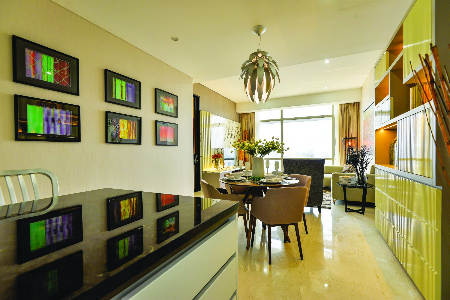
10 Ideas for Combining Your Dining and Living Spaces
Friday, November 20, 2020
Beyond just arranging dining and living room furniture sets near each other, there are a host of other considerations that one should look into when combining these two functionally separate areas.
 Interior design by: Kuzoj
Interior design by: Kuzoj
With space at a premium in urban homes, combining two of the areas that often take up the most space is a practical way of freeing up room for other functions. But things can get a little busy and cluttered when combining dining and living areas in small spaces such as a studio apartment or a home with an open floor plan. In light of the many ways that this merging can be achieved, we took a look at the most notable combined spaces we have seen over the years and extracted the base ingredients for your perusal here.
1. Grouped Arrangements
If you have the space to spare in your open plan home, the easiest way to combine the dining room with seating lounge is to position the respective furniture into two separate but adjacent groups - with an empty gap for a walkway between the two groups providing a means of access and to act as subtle demarcation.
 Interior design by: SQFT Space Design Management
Interior design by: SQFT Space Design Management
2. Narrow Spaces
For a comfortable dining experience, diners need between 90cm to 1.3m of space to be able to pull out a chair and take a seat, with around 60cm to 70cm of space between each seat for adequate elbow room. If space is limited, opt for a narrow rectangular table to discretely occupy the space on one side of the seating lounge.
 Interior design by: Pocket Square
Interior design by: Pocket Square
3. Informal Seating
At the most extreme end of the scale, one could also go beyond merging dining and living areas, by having seating and dining table occupy the same space. Replacing chairs on one side of a dining table with an upholstered bench creates a casual setting for meals and enables one to forgo having a sofa set - if the comfort and formality are not to be missed.
 Interior design by: The Roof
Interior design by: The Roof
4. Wall Features
To rein in the surplus empty space in your open plan layout, build up false wall projections and turn them into shelving or see-through niches to provide a means of visual separation as well as a functional fixture for additional storage.
 Interior design by: Beata Home and Office Furnishing
Interior design by: Beata Home and Office Furnishing
5. Decorative Ceilings
Even the thinnest of wall façades will take up some space, if only a negligible amount. To clearly demarcate your combined dining and seating lounge without occupying any of the valuable floor space, consider forming borders on the ceilings to visually indicate the extents of the functionally separate areas.
 Interior design by: Design Base
Interior design by: Design Base
6. Island Bars
Even without a dry kitchen adjacent to the seating lounge, it is possible to incorporate bar-height counters or kitchen islands - along with some stools or chairs of appropriate height, to provide a dining space in close proximity. Opting for countertop dining makes for a casual dining experience, and frees up additional space for other uses, such as a more spacious seating lounge.
 Interior design by: Pins Studio
Interior design by: Pins Studio
 Interior design by: Luna Solutions
Interior design by: Luna Solutions
7. Raised Platforms
With a small measure of additional space in an open floor plan, a slightly raised wooden platform would serve to elevate, highlight, and to keep the dining space visually distinct from any nearby seating.
 Interior design by: Pins Studio
Interior design by: Pins Studio
8. Decorative Archways
Building up a decorative archway between dining and seating furniture is another space-efficient way of define the combined areas, but best results are achieved in wide spaces so as not to make the open floor plan appear cramped.
 Interior design by: D'Concepto Design
Interior design by: D'Concepto Design
9. Dividing Drapery
In lieu of features such as arches, shelving, or see-through niches, an opaque or transparent curtain can be drawn shut to provide a temporary privacy screen during meals, and opened between meals to preserve the spaciousness of the open layout.
 Interior design by: Zids Design
Interior design by: Zids Design
10. Unifying Style
Whatever the means you have chosen to apply in visually indicating the separate functions of your combined dining and seating area, a harmoniously applied decorative style will serve to unify the distinct spaces. A unifying style does not necessarily entail a repeated palette, as a cohesive décor can still be achieved with complementary colour pairs applied as interchangeable base and accent colours.
 Interior design by: Nu Infinity
Interior design by: Nu Infinity

Centre of Attention: 7 Centrepiece Ideas for Your Dining Table
Friday, November 20, 2020
If you have just finished adjusting your dining table and meticulously arranging it in place in your home, only to have that nagging feeling that the décor is somehow incomplete, it is because the space needs a centrepiece.
You could do as one does and just let clutter accumulate just to see what happens, the random assortment of items will eventually speak of your personality and lifestyle, but it may not blend well with the rest of the space - that and most would regard that as an unintended mess. We let our panel of decorators into our homes to help us figure out centrepieces, and arrived at the following Top 7 ideas that will help you get ahead of the curve by tailoring your dining table decorations to suit your interior and to project the ambiance you design.
 Designer: Konan Design
Designer: Konan Design
7. Classic Candlelight The original dining table centrepiece - the archetypal candle and candle-holder combination has been a pervasive decorative element, providing a form of lighting especially suited for intimate moods, and appearing in everything from classical art to modern fine dining experiences. Candle-holders serve as pieces of art in themselves, ranging from ostentatious candelabra gilded in precious metals to utilitarian glassware.
 Designer: SQFT Space Design Management
Designer: SQFT Space Design Management
6. Edible Art Food invariably gets left on the dining table in some way or another - especially with large households in constant flux, where mealtimes tend to overlap. Embrace the familial chaos while encouraging healthy eating by displaying brightly coloured fruit or snacks in attractive containers to provide an additional decorative element. To take it a step further, unleash the inner epicurean and artist by experimenting with pickled or dried edibles in jars to produce a few splashes of colour.
 Designer: Surface R Interior Design
Designer: Surface R Interior Design
5. Rotating Trays A mainstay of oriental-styled interiors, the turntable - known in some circles as the "Lazy Susan", is a rotating tray made of wood or stone. Typically found in the centre of large Chinese dinners, the turntable adds a functional and elegant layer to round dining tables that serves equally well as a pedestal for art or dining accessories - while providing diners with Arthurian access to the dishes placed on it.
 Designer: Jashen Interior Design
Designer: Jashen Interior Design
4. Sculptures On the other end of the function-form spectrum are gratuitous objects of art to inject some glam and glitter into a scene and turn a dining table into a display space. A curated sculpture with interesting reliefs on all sides provides luxurious views from any angle in combination with a rotating tray.
 Designer: Gusto Design
Designer: Gusto Design
3. Literary Pursuits In lieu of spending the time combing galleries and markets for "that ideal piece", go the way of the literary artist by shaping an impromptu sculpture out of books to accent a loft-like décor. Especially in small spaces where coffee table space is scarce, books that were intended for the seating lounge can be piled up on the dining table instead, freeing up living room space and providing a set of spontaneous talking points while dining.
 Designer: M Innovative Builders
Designer: M Innovative Builders
2. Living Embellishments A simple and immediately rewarding centrepiece element comes from our own lush backyards. All that is needed is a few stalks of freshly-cut flowers, or sprigs of herbs, thrown into a container - anything from an old tea tin to an intricate glass vase would do the job. While these living centrepieces can only be expected to last little more than a few days, an extra "wow" could be elicited with a contained ecosystem of live fish and water plants in the centre of the dining table.
 Designer: Q1 Interior
Designer: Q1 Interior
1. Clutter Trays To keep that assortment of decorative and functional items in check, consider using a tray in wood or metal to neatly present dining table accessories, and to add another layer of texture to dining surfaces. Aside from the obvious practical application, clutter trays can also be used to frame other decorative elements, or even create a mini Zen garden with appropriately deep trays filled with sand.
 Designer: X-Two Concept
If you haven't already, click here to take a look at our definitive guide for selecting the right kind of dining table to suit your interior.
Designer: X-Two Concept
If you haven't already, click here to take a look at our definitive guide for selecting the right kind of dining table to suit your interior.
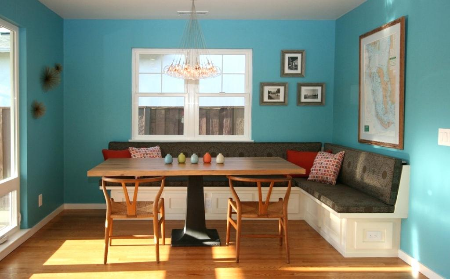
Bench Warmers: Bench Seating Ideas for the Dining Room
Friday, November 20, 2020
The grandeur and pageantry of formal dinners have faded from modern landscapes as much as the detachable starched collar - so has the prevalence of gratuitous dining arrangements in the compact urban homes of our present age. Given the space most of us get to work with, our common dining arrangements have evolved to facilitate more casual meals in the interest of limiting footprints and conserving space: with a bench taking up the same amount of floor space as - if not less than, several dining chairs. If you’ve come across our pointers on how to set up a compact or minimalist dining space, you may be interested in going through the various ways one can assemble casual bench seating or restaurant style banquette arrangements.
Countryside Charm
 Image source: Sustainable Pals
Image source: Sustainable Pals
A banquette arrangement surrounded by walls in pastel blue and floors decked in wood immediately evokes imagery of countryside skylines. The classical rendering of a dining space from rural environments is reinforced by the decorative trim lining the base of the banquette seating and the intricate motifs sewn into the fabric of the cushions. The accompanying chairs are composed from frames of wood in a shade matching the floor, and a dining table with a single plinth instead of multiple legs is selected - so as not to detract from the ornate decorative features of the banquette’s base.
Rustic Industrial
 Image source: Hafoti
Image source: Hafoti
With a bench bearing the same design and composed of the same materials as the dining surface it accompanies, the result is a cohesive arrangement that does more to maintain a sense of space. The pictured arrangement is placed over a simplistic weaved textile rug and furnished by rustic constructions of darkly lacquered wood. The individual pieces of wood are joined in the fashion of traditional carpentry - with both hidden and overt varieties of the common mortise and tenon joints, while the frames are bound by reinforcing bars that are held in tension with industrial coupling attachments of vintage origin.
Provençal Defined
 Image source: Geoloqal
Image source: Geoloqal
The intermingling of classical and rustic vibes in this dining space is the very definition of Provençal style - with a coffered ceiling and ornate decorative plaster trim on the surrounding whitewashed walls. The furnishings are composed of visibly aged wood and upholstered with simplistic fabrics, with the bench constructed out of the same materials and bearing the same rustic design of the through mortise and tenon joints as seen in the legs of the dining surface. The incorporation of a quintessential stone planter bowl decorated with lion heads, and the pair of cyclopean chandeliers - vintage metal chandeliers encased in metal rings appropriated from wine barrels, further reinforce the Provençal ancestry of the décor.
Country Light
 Image source: Dans Design Magz
Image source: Dans Design Magz
The pictured dining arrangement evokes imagery of the European countryside with seat cushions upholstered in a deep blue fabric bearing geometric motifs in white to match the surrounding walls. The accompanying furnishings are deliberately selected for their space-saving designs: Eero Saarinen’s 78-inch diameter Oval seats up to eight diners, while its robust cast-moulded aluminium base minimises the expected clutter of table legs against the scant floor space. The accompanying chairs are the DSW variation of the Eames duo’s moulded polypropylene shell from the 1950s, mounted on the Scandinavian reinterpretation of the iconic Eiffel Tower legs seen in the DSR original. Punctuating this space when lit but camouflaged against the background when not needed, is the lighting fixture known as "PH 4/3" - a Poul Henningsen creation based on his famed Artichoke.
Understated Sophistication
 Image source: Listspirit
Image source: Listspirit
A vintage banquette assembly, subtly speaking in minimalist tones of the kind of décor associated with the American Prohibition era, is composed out of velvet capitoné upholstery in drab olive. The shade of the bench cushions is complemented by a regal slab of serpentine marble bearing serene swirls of white against a background of dusky green. The table’s box steel legs of minimalist design are contrasted in monochromatic fashion against the polished tubular steel frames of the accompanying chairs - the Cesca variation of Mart Stam’s iconic S33 cantilever chairs from 1927, with hand-woven cane weave inserts added by Marcel Breuer in 1928.
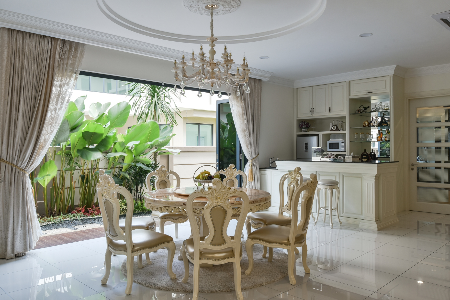
Dine in Style: A Dining Table Buying Guide for Every Homeowner
Friday, November 20, 2020
As the dining space is arguably the most likely part of a home where family members can be expected to congregate, the selection of a dining table is probably the most important decision to be made - at least with regards to furnishings. We understand that the wide range of styles and materials available for dining tables may be overwhelming for most, so we put together this definitive guide to assist you in your search for the perfect dining table.
Material
The materials commonly used in dining tables greatly affect their longevity in terms of substance as well as style. Hardwoods, metals, tempered glass, stone, and even mould-injected plastics tend to be the materials of choice for long-term furnishings expected to endure years of physical impacts and spills. On the end of the scale would be the lightweight or flat-pack designs composed of veneered wood composites such as plywood and fibreboard. These engineered composites are significantly less durable, showing a tendency to warp when subjected to excessive moisture or heat. On the plus side, tables made of these materials are preferred for short-term and low-frequency applications as they tend to be easier to repack and move by design.
Natural materials such as hardwoods and stone tend to be porous, requiring regular maintenance and a coat of varnish or sealer to prevent permanent staining from everyday use - however artisans attest to some aesthetic benefits derived from a deliberate patina providing a personalized tinge to these natural materials.
 Natural materials such as hardwoods and stone tend to be porous, requiring regular maintenance and a coat of varnish or sealer to prevent permanent staining from everyday use. From iN Design Bumper Issue 2016. Image Credit: Latitude Design
Natural materials such as hardwoods and stone tend to be porous, requiring regular maintenance and a coat of varnish or sealer to prevent permanent staining from everyday use. From iN Design Bumper Issue 2016. Image Credit: Latitude Design
Metals would also need to be protected, albeit to a lesser degree by virtue of their inherent durability. Metal furnishings are at the highest risk of deterioration by rust when used outdoors, and especially when lacking a protective coating. To ensure the longest possible lifespan, a metal dining table should be powder-coated in carbon to provide protection against scratches.
Dining tables sporting tempered glass tops are much sought after as they provide a balance between eye-pleasing aesthetics and durability in their reflective surfaces. While glass is naturally lower in impact resistance when compared to metal, modern tempered glass is manufactured at such high pressures that its durability is virtually guaranteed in everyday circumstances.
 Dining tables sporting tempered glass tops are much sought after as they provide a balance between eye-pleasing aesthetics and durability in their reflective surfaces. From iN Design Bumper Issue 2016. Image Credit: The Roof Studio
Dining tables sporting tempered glass tops are much sought after as they provide a balance between eye-pleasing aesthetics and durability in their reflective surfaces. From iN Design Bumper Issue 2016. Image Credit: The Roof Studio
Mould-injected plastics are likely the most economical and durable solution for outdoor applications but as white plastics tend to turn yellow with age, care should be taken to minimize their exposure to direct sunlight.
Size
One of the most crucial considerations for your dining table would be its dimensions, as a dining table that is too large for its space forces diners to squeeze through narrow gaps between the wall and their seats. We recommend allowing for gaps between 90 centimetres to 1.3 meters (or 36 to 50 inches) of space between a dining table and the surrounding walls to enable diners to comfortably take their seats.
 We recommend allowing for gaps between 90 centimetres to 1.3 meters (or 36 to 50 inches) of space between a dining table and the surrounding walls to enable diners to comfortably take their seats. From iN Design issue #66. Image Credit: Design Base Interior
We recommend allowing for gaps between 90 centimetres to 1.3 meters (or 36 to 50 inches) of space between a dining table and the surrounding walls to enable diners to comfortably take their seats. From iN Design issue #66. Image Credit: Design Base Interior
Diners should be provided with ample elbow room to allow for a relaxing dining experience. Our recommendations are to provide each diner with around 60 to 70 centimetres (or 24 to 28 inches) of space. With this rule in mind, one can accurately determine the appropriate size for a dining surface needed to serve a particular number of diners.
Shape
The shape of a dining table should also be considered, as rectangular tables tend to accommodate fewer diners than round tables of a similar size. To calculate the number of diners appropriate for a round table: multiply the diameter of a table by the value of Pi (π: 3.14) and divide the result by the amount of space needed for each diner.
 Assuming a minimum of 60 centimetres (or 24 inches) of space needed per diner, a round table with a diameter of 1.5 meters can easily accommodate 7 diners. From iN Design Bumper Issue 2016. Image Credit: Turn Design Interior
Assuming a minimum of 60 centimetres (or 24 inches) of space needed per diner, a round table with a diameter of 1.5 meters can easily accommodate 7 diners. From iN Design Bumper Issue 2016. Image Credit: Turn Design Interior
Assuming a minimum of 60 centimetres (or 24 inches) of space needed per diner, a round table with a diameter of 1.5 meters can easily accommodate 7 diners, or up to 8 diners with a negligible reduction in elbow room. A rectangular table that is 1.5 meters long can only seat a total of 6 diners - one at each end and two along each length.
 A rectangular table that is 1.5 meters long can only seat a total of 6 diners – one at each end and two along each length. From iN Design issue #71. Image Credit: Pocket Square
A rectangular table that is 1.5 meters long can only seat a total of 6 diners – one at each end and two along each length. From iN Design issue #71. Image Credit: Pocket Square
The choice of a dining table's shape has a noticeable effect on the space it occupies. Round tables, while capable of accommodating a greater number of diners, tend to appear imposing in tight quarters and are generally not suitable for small dining spaces as a result. Conversely, the more conventional rectangular dining tables take up the most space, requiring long and narrow spaces to avoid appearing out of proportion.
 Round tables, while capable of accommodating a greater number of diners, tend to appear imposing in tight quarters. From iN Design Bumper Issue 2015. Image Credit: D'concepto Design
Round tables, while capable of accommodating a greater number of diners, tend to appear imposing in tight quarters. From iN Design Bumper Issue 2015. Image Credit: D'concepto Design
 Rectangular dining tables take up the most space, requiring long and narrow spaces to avoid appearing out of proportion. From iN Design issue #78. Image Credit: Living Space Creative Design
Rectangular dining tables take up the most space, requiring long and narrow spaces to avoid appearing out of proportion. From iN Design issue #78. Image Credit: Living Space Creative Design
Height
Dining tables are commonly manufactured within a standard range of heights, from 710 to 760 centimetres (or between 28 to 30 inches), which makes finding them a relatively easy task. The key considerations to apply when looking at the various heights of dining tables is that the surface should be sufficiently low to provide an ergonomic resting place for arms, while the support structures beneath the surface should be sufficiently high to prevent knocking against knees.
To conserve floor space for smaller dining areas, open layout concepts, or simply for variation - consider counter-height tables, measuring up to 910 centimetres (or 36 inches) in height to join with kitchen counters, or bar-style tables around one meter in height.
 Consider counter-height tables, measuring up to 910 centimetres (or 36 inches) in height to join with kitchen counters. From iN Design magazine issue #74. Image Credit: Nu Infinity
Consider counter-height tables, measuring up to 910 centimetres (or 36 inches) in height to join with kitchen counters. From iN Design magazine issue #74. Image Credit: Nu Infinity
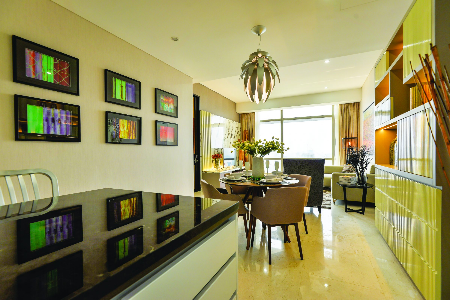
10 Ideas for Combining Your Dining and Living Spaces
Friday, November 20, 2020
Beyond just arranging dining and living room furniture sets near each other, there are a host of other considerations that one should look into when combining these two functionally separate areas.
 Interior design by: Kuzoj
Interior design by: Kuzoj
With space at a premium in urban homes, combining two of the areas that often take up the most space is a practical way of freeing up room for other functions. But things can get a little busy and cluttered when combining dining and living areas in small spaces such as a studio apartment or a home with an open floor plan. In light of the many ways that this merging can be achieved, we took a look at the most notable combined spaces we have seen over the years and extracted the base ingredients for your perusal here.
1. Grouped Arrangements
If you have the space to spare in your open plan home, the easiest way to combine the dining room with seating lounge is to position the respective furniture into two separate but adjacent groups - with an empty gap for a walkway between the two groups providing a means of access and to act as subtle demarcation.
 Interior design by: SQFT Space Design Management
Interior design by: SQFT Space Design Management
2. Narrow Spaces
For a comfortable dining experience, diners need between 90cm to 1.3m of space to be able to pull out a chair and take a seat, with around 60cm to 70cm of space between each seat for adequate elbow room. If space is limited, opt for a narrow rectangular table to discretely occupy the space on one side of the seating lounge.
 Interior design by: Pocket Square
Interior design by: Pocket Square
3. Informal Seating
At the most extreme end of the scale, one could also go beyond merging dining and living areas, by having seating and dining table occupy the same space. Replacing chairs on one side of a dining table with an upholstered bench creates a casual setting for meals and enables one to forgo having a sofa set - if the comfort and formality are not to be missed.
 Interior design by: The Roof
Interior design by: The Roof
4. Wall Features
To rein in the surplus empty space in your open plan layout, build up false wall projections and turn them into shelving or see-through niches to provide a means of visual separation as well as a functional fixture for additional storage.
 Interior design by: Beata Home and Office Furnishing
Interior design by: Beata Home and Office Furnishing
5. Decorative Ceilings
Even the thinnest of wall façades will take up some space, if only a negligible amount. To clearly demarcate your combined dining and seating lounge without occupying any of the valuable floor space, consider forming borders on the ceilings to visually indicate the extents of the functionally separate areas.
 Interior design by: Design Base
Interior design by: Design Base
6. Island Bars
Even without a dry kitchen adjacent to the seating lounge, it is possible to incorporate bar-height counters or kitchen islands - along with some stools or chairs of appropriate height, to provide a dining space in close proximity. Opting for countertop dining makes for a casual dining experience, and frees up additional space for other uses, such as a more spacious seating lounge.
 Interior design by: Pins Studio
Interior design by: Pins Studio
 Interior design by: Luna Solutions
Interior design by: Luna Solutions
7. Raised Platforms
With a small measure of additional space in an open floor plan, a slightly raised wooden platform would serve to elevate, highlight, and to keep the dining space visually distinct from any nearby seating.
 Interior design by: Pins Studio
Interior design by: Pins Studio
8. Decorative Archways
Building up a decorative archway between dining and seating furniture is another space-efficient way of define the combined areas, but best results are achieved in wide spaces so as not to make the open floor plan appear cramped.
 Interior design by: D'Concepto Design
Interior design by: D'Concepto Design
9. Dividing Drapery
In lieu of features such as arches, shelving, or see-through niches, an opaque or transparent curtain can be drawn shut to provide a temporary privacy screen during meals, and opened between meals to preserve the spaciousness of the open layout.
 Interior design by: Zids Design
Interior design by: Zids Design
10. Unifying Style
Whatever the means you have chosen to apply in visually indicating the separate functions of your combined dining and seating area, a harmoniously applied decorative style will serve to unify the distinct spaces. A unifying style does not necessarily entail a repeated palette, as a cohesive décor can still be achieved with complementary colour pairs applied as interchangeable base and accent colours.
 Interior design by: Nu Infinity
Interior design by: Nu Infinity
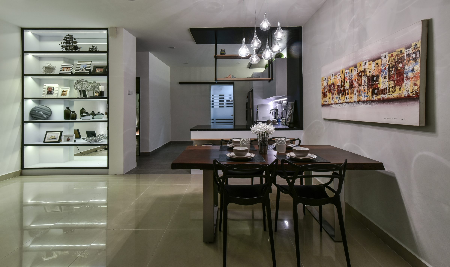
Delectable Walls: 5 Ways to Decorate Your Dining Room Walls
Friday, November 20, 2020
Decorating walls can be so much more than a mere matter of the colour of paint you apply or the school of art you subscribe to, beneath it all is a landscape of subtle considerations in terms of theme, material, and arrangement of elements. If you have the wall space to spare, consider these five ways of decorating your dining room walls to achieve effects ranging from eccentric to elegant.
1. Transposed Landscapes Interior design by: Moonlit Inspiration
Interior design by: Moonlit Inspiration
Evoking high-street galleries and art collectives of post-industrial environements, an unframed canvas introduces a contained burst of colour over a briskly white washed cement wall that serves as the background. The rectangular dimensions of the canvas are repeated in the simplistic black frame of a nearby shelving unit, while the bright display lighting and mirrored back panel contribute to the gallery ambiance.
2. Eclectic Ensemble
 Interior design by: Viincology
Interior design by: Viincology
An arrangement blending imagery evocative of England and times past: a replica of the London Underground’s roundel occupies a prominent position on the nearby wall, the field framed in warm white down-lights while a bench invitingly dotted with throw pillows underscores the arrangement. The adjacent walls host arrays of same-sized, framed motivational prints in the style of vintage advertorial flyers to add a layer of retro vibes to the eccentric décor.
3. Material Contrast
 Interior design by: Q1 Interior Concept
Interior design by: Q1 Interior Concept
The dining furniture sit at a convergence of contrasting themes: one wall bears framed images of river pebbles in their natural environment, the meditative photo prints seemingly suspended on vinyl cut-outs of birch trees. The characteristically long horizontal lines of birch bark are echoed in with reflective metallic accents lining the adjacent wall of peach-coloured stone.
4. Cohesive Display
 Interior Design by: Jashen Interior Design
Interior Design by: Jashen Interior Design
A wide field of brown on the adjacent wall adds a dimension to the monochromatic palette of the dining furniture, visually expanding the space by bridging the gap between the dark upholstery and the pale architectural finishes. An unframed abstract painting occupies the central position on the wall, its dimensions sitting neatly within the frame of the banquette arrangement.
5. Layered Presentation
 Interior design by: KP Property Design Team
Interior design by: KP Property Design Team
The glistening and colour-rich décor of this dining room is contrasted by a white wall, marked by grids with wide borders, serving as the backdrop for a monochromatic product of an ink roller and stencil. The abstract rendering and its simplistic background draw the naïve eye with the contradiction of black and white amidst a burst of colour.
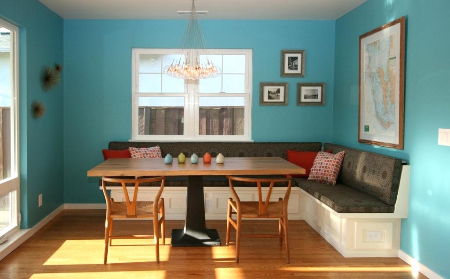
Bench Warmers: Bench Seating Ideas for the Dining Room
Friday, November 20, 2020
The grandeur and pageantry of formal dinners have faded from modern landscapes as much as the detachable starched collar - so has the prevalence of gratuitous dining arrangements in the compact urban homes of our present age. Given the space most of us get to work with, our common dining arrangements have evolved to facilitate more casual meals in the interest of limiting footprints and conserving space: with a bench taking up the same amount of floor space as - if not less than, several dining chairs. If you’ve come across our pointers on how to set up a compact or minimalist dining space, you may be interested in going through the various ways one can assemble casual bench seating or restaurant style banquette arrangements.
Countryside Charm
 Image source: Sustainable Pals
Image source: Sustainable Pals
A banquette arrangement surrounded by walls in pastel blue and floors decked in wood immediately evokes imagery of countryside skylines. The classical rendering of a dining space from rural environments is reinforced by the decorative trim lining the base of the banquette seating and the intricate motifs sewn into the fabric of the cushions. The accompanying chairs are composed from frames of wood in a shade matching the floor, and a dining table with a single plinth instead of multiple legs is selected - so as not to detract from the ornate decorative features of the banquette’s base.
Rustic Industrial
 Image source: Hafoti
Image source: Hafoti
With a bench bearing the same design and composed of the same materials as the dining surface it accompanies, the result is a cohesive arrangement that does more to maintain a sense of space. The pictured arrangement is placed over a simplistic weaved textile rug and furnished by rustic constructions of darkly lacquered wood. The individual pieces of wood are joined in the fashion of traditional carpentry - with both hidden and overt varieties of the common mortise and tenon joints, while the frames are bound by reinforcing bars that are held in tension with industrial coupling attachments of vintage origin.
Provençal Defined
 Image source: Geoloqal
Image source: Geoloqal
The intermingling of classical and rustic vibes in this dining space is the very definition of Provençal style - with a coffered ceiling and ornate decorative plaster trim on the surrounding whitewashed walls. The furnishings are composed of visibly aged wood and upholstered with simplistic fabrics, with the bench constructed out of the same materials and bearing the same rustic design of the through mortise and tenon joints as seen in the legs of the dining surface. The incorporation of a quintessential stone planter bowl decorated with lion heads, and the pair of cyclopean chandeliers - vintage metal chandeliers encased in metal rings appropriated from wine barrels, further reinforce the Provençal ancestry of the décor.
Country Light
 Image source: Dans Design Magz
Image source: Dans Design Magz
The pictured dining arrangement evokes imagery of the European countryside with seat cushions upholstered in a deep blue fabric bearing geometric motifs in white to match the surrounding walls. The accompanying furnishings are deliberately selected for their space-saving designs: Eero Saarinen’s 78-inch diameter Oval seats up to eight diners, while its robust cast-moulded aluminium base minimises the expected clutter of table legs against the scant floor space. The accompanying chairs are the DSW variation of the Eames duo’s moulded polypropylene shell from the 1950s, mounted on the Scandinavian reinterpretation of the iconic Eiffel Tower legs seen in the DSR original. Punctuating this space when lit but camouflaged against the background when not needed, is the lighting fixture known as "PH 4/3" - a Poul Henningsen creation based on his famed Artichoke.
Understated Sophistication
 Image source: Listspirit
Image source: Listspirit
A vintage banquette assembly, subtly speaking in minimalist tones of the kind of décor associated with the American Prohibition era, is composed out of velvet capitoné upholstery in drab olive. The shade of the bench cushions is complemented by a regal slab of serpentine marble bearing serene swirls of white against a background of dusky green. The table’s box steel legs of minimalist design are contrasted in monochromatic fashion against the polished tubular steel frames of the accompanying chairs - the Cesca variation of Mart Stam’s iconic S33 cantilever chairs from 1927, with hand-woven cane weave inserts added by Marcel Breuer in 1928.
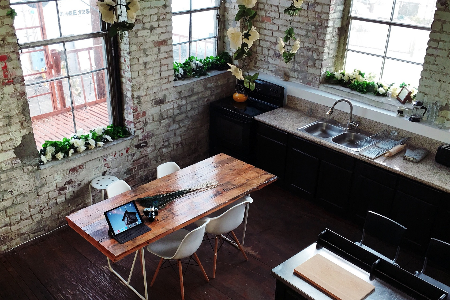
How to Create a Dining Area with Limited Space
Friday, November 20, 2020
 If your living space is on the small side, it can be difficult to carve out a designated spot exclusively for dining. However, it would be even more confining to forego this essential home comfort. No one wants to be forced to eat every meal standing up or with a plate balanced on their laps--and even if they do, it shouldn’t always be the case. Shared family meals are an important ingredient in a healthy lifestyle, even when the family consists of just two people or one person simply having guests over from time to time. Here are some ideas on how to create a cozy dining area when space is at a premium:
Make the area serve double duty
There's no reason why the dining nook can't also be a work space, a prep table, a gaming surface, or all the above. Just be sure to clear away anything that isn't dining-related when it's time for dinner – it doesn't count if the laptop is still balanced on the edge of the table.
If your living space is on the small side, it can be difficult to carve out a designated spot exclusively for dining. However, it would be even more confining to forego this essential home comfort. No one wants to be forced to eat every meal standing up or with a plate balanced on their laps--and even if they do, it shouldn’t always be the case. Shared family meals are an important ingredient in a healthy lifestyle, even when the family consists of just two people or one person simply having guests over from time to time. Here are some ideas on how to create a cozy dining area when space is at a premium:
Make the area serve double duty
There's no reason why the dining nook can't also be a work space, a prep table, a gaming surface, or all the above. Just be sure to clear away anything that isn't dining-related when it's time for dinner – it doesn't count if the laptop is still balanced on the edge of the table.
 Choose furniture wisely
Obviously, a dining table that seats six (complete with wing-back chairs) is out of the question, but there are plenty of other attractive options out there for those with limited space. To name just a few:
Choose furniture wisely
Obviously, a dining table that seats six (complete with wing-back chairs) is out of the question, but there are plenty of other attractive options out there for those with limited space. To name just a few:
- Low, narrow trestle tables
- Benches or banquettes (some of these will even have additional storage underneath, providing more bang for your buck)
- Round, bistro-style tables (even ones that are meant for patio use can work well in a small space)
- Stools that fit easily underneath whichever table you choose
- Folding tables and chairs that can be stored elsewhere when the meal is over
 Paint in light colors
Neutrals and light pastels will help to "air out" more cramped areas even if the rest of the room is painted in a darker shade. A light accent wall could be just the ticket. If the furniture can be painted as well, choose either the same color or a complementary hue to round out the look.
Opt for shelves instead of cupboards
In small kitchens, shelves can be a dream come true--they open the flow of the room and provide storage for just about anything the homemaker can think of. If a renovation on this scale isn't in the cards, simply removing a few of the cupboard doors will work wonders.
Think mirrors
The dining nook is the perfect place for that extra mirror you weren't sure what to do with, as the reflection will provide the illusion of more space. If you don't have one to spare, invest in an inexpensive one that will suit your tastes.
Use the shape of the room to your advantage
For long, narrow spaces, choose a table with a corresponding shape and benches that will fit easily underneath. If the dining area is to take up a corner of the room, shake up the geometry with a round table and a banquette that fits against the wall. The idea is for the pieces to look like they belong without sacrificing style and function.
Paint in light colors
Neutrals and light pastels will help to "air out" more cramped areas even if the rest of the room is painted in a darker shade. A light accent wall could be just the ticket. If the furniture can be painted as well, choose either the same color or a complementary hue to round out the look.
Opt for shelves instead of cupboards
In small kitchens, shelves can be a dream come true--they open the flow of the room and provide storage for just about anything the homemaker can think of. If a renovation on this scale isn't in the cards, simply removing a few of the cupboard doors will work wonders.
Think mirrors
The dining nook is the perfect place for that extra mirror you weren't sure what to do with, as the reflection will provide the illusion of more space. If you don't have one to spare, invest in an inexpensive one that will suit your tastes.
Use the shape of the room to your advantage
For long, narrow spaces, choose a table with a corresponding shape and benches that will fit easily underneath. If the dining area is to take up a corner of the room, shake up the geometry with a round table and a banquette that fits against the wall. The idea is for the pieces to look like they belong without sacrificing style and function.
 Don't forget the tape measure
Know the dimensions of the space you're looking to fill and bring the measuring tape along on any shopping expeditions. It wouldn't do to purchase what appears to be the perfect piece only to come home and realize it doesn't fit in the spot it was meant to go.
Small spaces don't have to be confined spaces, nor does one need to be overly skilled in interior design to create a dining area that serves its vital purpose. Armed with a good sense of the room's visual flow, its dimensions and measurements, and these guidelines, anyone can create a quaint place to dine in a cozy space!
Olivia Warfield is a contributing writer and media relations specialist for Port Orchard Roofing. She writes for a variety of DIY and lifestyle blogs.
Don't forget the tape measure
Know the dimensions of the space you're looking to fill and bring the measuring tape along on any shopping expeditions. It wouldn't do to purchase what appears to be the perfect piece only to come home and realize it doesn't fit in the spot it was meant to go.
Small spaces don't have to be confined spaces, nor does one need to be overly skilled in interior design to create a dining area that serves its vital purpose. Armed with a good sense of the room's visual flow, its dimensions and measurements, and these guidelines, anyone can create a quaint place to dine in a cozy space!
Olivia Warfield is a contributing writer and media relations specialist for Port Orchard Roofing. She writes for a variety of DIY and lifestyle blogs.





